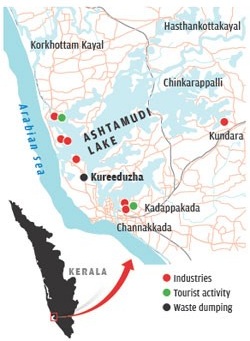Why in the News?
In Ashtamudi Lake, Kerala, artisanal fishers and Indo-Pacific humpback dolphins (Sousa plumbea) engage in a rare and sophisticated form of human–wildlife cooperative hunting.

Unique Dolphin-Fisher in Ashtamudi Lake:
|
About Indo-Pacific Humpback Dolphins (Sousa plumbea):
- Distribution: Found from East Africa to India, the Middle East and western Indochina, with major populations along India’s west coast.
- Appearance: Identified by a large hump under the dorsal fin, dark grey plumbeous body, white mottling, and occasional pink shading; adults grow up to 2.8 m, newborns 97–108 cm.
- Identification Traits: Long slender beak, dorsal fin perched on a mid-back hump, adults darken with age and often show shark-related scars.
- Habitat: Prefer shallow waters (<20 m) within 1.5 km of shore; commonly near estuaries, river mouths, bays and nearshore fish concentrations.
- Group Behaviour: Groups of 50–100 reported in India; shy but often seen during dolphin-watching trips.
- Diet: Feed mainly on mullet, mackerel, sardines, pomfret and other schooling fish; sometimes exploit fishing nets, increasing entanglement risk.
- Conservation Status: Vulnerable (IUCN), Appendix I (CITES), NOT LISTED under India’s Wildlife Protection Act (only Ganges and Snubfin dolphins are listed).
- Colour Variation: Pinkish tint comes from superficial blood vessels used for thermoregulation; calves are dark grey.

About Ashtamudi Lake:
- Location: A brackish estuarine lake in Kerala covering 5,700 hectares; designated a Ramsar Site (2002).
- Name Origin: “Ashtamudi” refers to its eight channels, forming a gateway to the Kerala backwaters.
- Hydrology: Fed mainly by the Kallada River; empties into the Arabian Sea via Neendakara estuary.
- History: Once the ancient port of Quilon mentioned by Ibn Battuta.
- Flora: Mangroves include Avicennia officinalis, Bruguiera gymnorrhiza, Sonneratia caseolaris; region hosts rare plants like Syzygium travancoricum and Calamus rotang.
- Fauna: Supports 57 bird species (6 migratory, 51 resident).
- Sustainable Fishery: Home to India’s first MSC-certified clam fishery (2014).
- Livelihood & Ecology: Vital for traditional fisheries, estuarine biodiversity, and local livelihood systems.
| [UPSC 2012] Which one of the following is not a lagoon?
Options: (a) Ashtamudi lake (b) Chilka lake (c) Preiyar lake * (d) Pulicat lake |
Get an IAS/IPS ranker as your 1: 1 personal mentor for UPSC 2024

